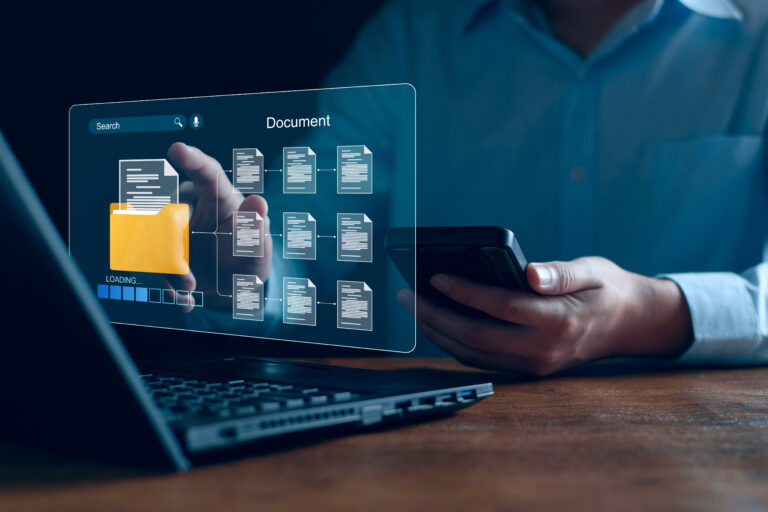Streamline Your Workflow with Document Scanning and Conversion to Electronic Format
Are you growing tired of dealing with hundreds of paper documents around your office and are curious about scanning conversion and eventually going paperless? Over the years, converting paper documents to electronic files has greatly benefited organizations looking to streamline their processes while lowering their reliance on traditional paper-based systems.
Paper-based systems are gradually becoming a thing of the past. They take up a tremendous amount of space and require time and effort to manage. They also make organizing and retrieving information more tedious. Additionally, misplaced documents can result in delays and even compliance issues. In this blog post, we’ll look further at document scanning and file conversion, the benefits of transitioning from paper to digital workflows, and how you can make your life easier by choosing trusted document scanning services from Archive Corporation.
The Process of Converting Paper Documents to Electronic Files
Figuring out how to convert your paper documents to electronic files might seem daunting; if you’re having difficulty with it, we at Archive Corporation are here to help.
A simplified process of the document conversion journey includes a couple of different steps.
Select and organize: The first step in the scanning conversion process involves figuring out what paper documents you want to be converted to electronic format. This means you may want to categorize your documents based on their importance and when you need them.
Pick a document scanner: The next step involves choosing the right document scanner for your needs. If you’re scanning hundreds of documents, you may want to choose a high-speed scanner equipped with automatic-feed functionality.
Get the documents ready: After choosing a scanner, you’ll get your documents all ready to be scanned. Ensure they’re correctly aligned in the scanner and don’t have any bends or folds in them.
Scanner settings: After that, you must adjust your scanner settings and file format. Higher resolutions are recommended if your documents have tiny fonts and important details.
Scan the documents: You’re now ready to scan your documents. Ensure you follow the manufacturer’s instructions on your device.
File naming convention: At this point, you can then organize the digital files in their applicable directory on your system.
If this process might seem confusing, you can take advantage of our reliable, accurate, and quick scanning services at Archive Corporation.
Key Benefits of Scanning and File Conversion
There are many benefits associated with scanning and file conversion.
Quick Retrieval
If you store your digital documents on a cloud-based server, you can retrieve them from anywhere where you have an internet connection. This empowers remote work and improved collaboration.
Document Management
Scanning and conversion reduce the need for physical storage space. That means you won’t have to worry about purchasing and organizing another file cabinet when your last one runs out of room.
Cost Savings
With more storage space freed up by not worrying about extra filing cabinets, scanning conversion will save you money in ink, paper, and document maintenance costs.
Disaster Recovery
In today’s digital age, you can easily back up your documents to ensure they’re protected against unforeseen events. Additionally, encryption methods can ensure your documents are secure and safe.
Environmental Sustainability
Converting a paper-based system to a digital one reduces paper waste and less energy consumption due to printing. This can effectively lower the carbon footprint of document management.
Overcoming Challenges in the Transition Process
A couple of challenges may arise during the scanning conversion process from paper to digital format.
Vast Quantities of Documents
The scanning conversion process can be overwhelming for individuals with many documents they want to convert to digital format. It’s helpful to start breaking up the process into manageable chunks to overcome this challenge. For example, if an individual has 200 different files they want to convert, it helps to start by categorizing those documents by their importance or what information is on them.
Sensitive Information
Protecting sensitive information is another challenge that may arise throughout the scanning conversion process. A company should always have clear and established protocols for handling documents with sensitive information on them. Employees should be trained on data security and proper document disposal practices.
Document Management Systems
Document management systems should be straightforward and user-friendly for all individuals using them. Scanning and file conversion isn’t a skill anyone can pick up. It requires training, support, and technical expertise.
Accessibility and Compatibility
Another challenge in the transition process is figuring out how to access scanned documents and if their file formats are compatible with your computer systems. PDF and JPEG file formats are generally compatible with most operating systems.
Choosing the Right Scanning and Conversion Solution
Unlocking the potential of digitized and easily accessible data can transform your company’s or personal workflows’ efficiency and effectiveness. It will save you time, resources, and unnecessary headaches. You won’t have to worry about scrolling through dozens of paper documents in your company’s filing cabinet, and you’ll no longer have to worry about endlessly searching for that one document that you can’t remember where you put.
If sifting through the various challenges we mentioned earlier causes you to feel anxious about converting paper documents to electronic files, why not reach out to us at Archive Corporation? We offer scanning services that enable you to locate your documents within seconds. Our origins date back to the early 1980s when we realized the challenges of storing information on 12” floppy disks.
We were motivated by these hurdles to create a business in data protection and records management. After four decades of experience in the field, we can proudly say we’ve become a trusted partner for many diverse clients. Don’t hesitate to simplify your life with our document scanning and conversion services.



